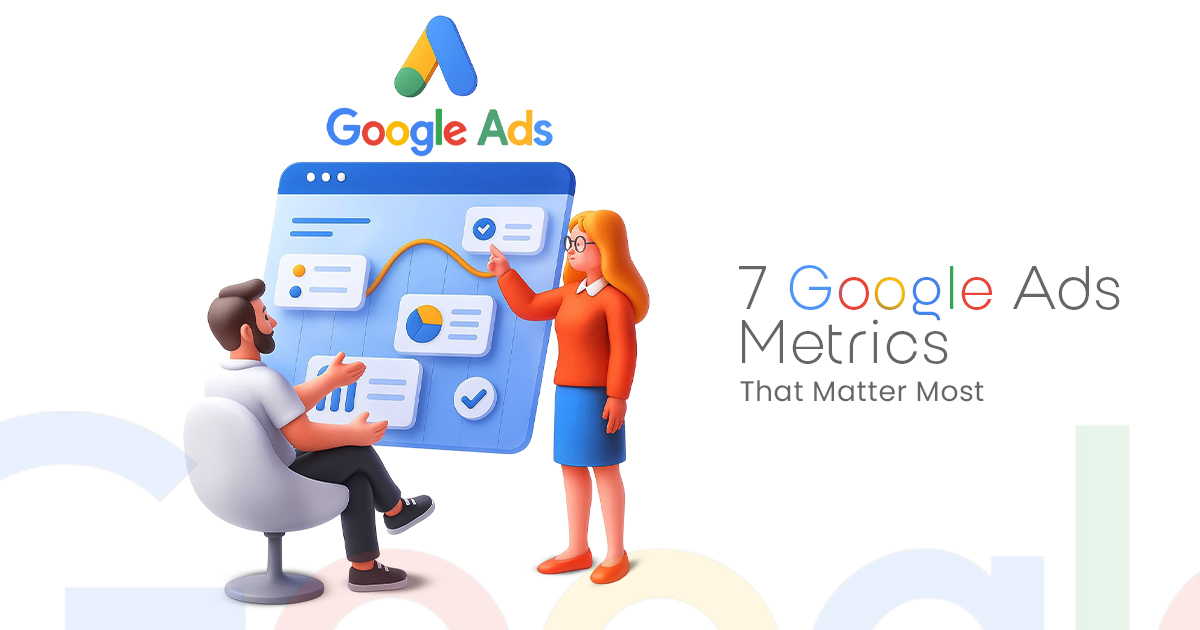Introduction: Why Metrics Matter in Google Ads
Google Ads is one of the most powerful tools for online advertising, but it can also be a money drain if you’re not tracking the right metrics. With dozens of data points available in every campaign, many marketers get overwhelmed or distracted by vanity numbers.
So what should you really focus on?
In this blog, we’ll reveal the top 7 Google Ads metrics that actually matter — the ones that tell you whether your campaign is truly successful or just eating up your budget. If you’re working with the best PPC advertising agency, these are the metrics they should be optimizing daily.
1. Click-Through Rate (CTR)
What It Is:
CTR = (Clicks / Impressions) × 100
This tells you how many users clicked on your ad after seeing it.
Why It Matters:
A high CTR means your ad is relevant and compelling to users. It also influences your Quality Score, which affects your ad rank and cost-per-click (CPC).
What to Watch For:
- Low CTR? Test new headlines, use stronger call-to-actions (CTAs), or improve audience targeting.
- Benchmark: A good CTR on search ads ranges between 3–5% depending on the industry.
2. Conversion Rate (CVR)
What It Is:
Conversion Rate = (Conversions / Clicks) × 100
It measures how many users take a desired action after clicking your ad (like filling out a form, buying a product, etc.).
Why It Matters:
High CTR means nothing if people aren’t converting. CVR reflects how well your landing page and offer are aligned with user intent.
Tips to Improve CVR:
- Optimize your landing page design and speed.
- Match your ad copy with the page headline.
- Simplify forms or checkout processes.
3. Cost Per Conversion (CPC or CPA)
What It Is:
Cost per Conversion = Total Ad Spend / Total Conversions
Why It Matters:
This metric helps you evaluate ROI. A lower cost per acquisition (CPA) means you’re getting more value from your budget.
Pro Tip from the Best PPC Advertising Agency:
Don’t aim for the cheapest clicks — aim for cost-effective conversions. A more expensive ad that converts better is often more profitable.
4. Quality Score
What It Is:
A score from 1 to 10 that Google assigns to your keyword, based on:
- CTR
- Ad relevance
- Landing page experience
Why It Matters:
Higher Quality Scores reduce your CPC and improve ad positioning. Google rewards advertisers who create helpful, relevant experiences for users.
How to Improve It:
- Write tightly themed ad groups.
- Use high-intent keywords.
- Deliver strong landing page UX.
5. Impression Share
What It Is:
Impression Share = (Actual Impressions / Total Eligible Impressions)
Why It Matters:
This tells you how much of the market you’re capturing. If your impression share is low, your competitors are showing more often — and getting the clicks.
Types to Track:
- Search Impression Share: For search campaigns.
- Display Impression Share: For banner/display ads.
- Lost IS (budget or rank): Tells you if you’re missing out due to limited budget or low ad rank.
6. Return on Ad Spend (ROAS)
What It Is:
ROAS = Revenue / Ad Spend
Why It Matters:
ROAS is the ultimate profitability metric. It shows whether you’re getting a return on your investment. A ROAS of 4x means you earned ₹4 for every ₹1 spent.
Ideal ROAS Benchmarks:
- E-commerce: Aim for 4x or higher
- Lead generation: Depends on lifetime value (LTV) of a customer
The Best PPC Advertising Agencies analyze ROAS by campaign, keyword, and device to find your most profitable segments.
7. Search Term Performance
What It Is:
The actual search queries that triggered your ads.
Why It Matters:
Google Ads matches your keywords to real searches. Reviewing the search terms report helps you:
- Add high-performing queries as keywords
- Identify irrelevant terms and add them as negative keywords
Why It’s Underrated:
Many advertisers overlook this goldmine of data. Optimizing based on search terms improves relevance and reduces wasted spend.
Bonus Metrics (Track, But Don’t Obsess Over):
- Bounce Rate: Useful for diagnosing landing page issues.
- Average CPC: Good for budgeting, but doesn’t always reflect value.
- Ad Position: More relevant for visibility than performance.
Metric Mistakes to Avoid
❌ Focusing only on clicks or impressions
❌ Ignoring Quality Score and relevance
❌ Measuring success only by CPC (not conversion or ROAS)
❌ Not aligning metrics with business goals (sales, leads, etc.)
How the Best PPC Advertising Agency Tracks These Metrics
A top-performing PPC campaign doesn’t chase every number — it focuses on what moves the needle. The best PPC advertising agency will:
- Set up conversion tracking through Google Tag Manager and Google Analytics
- Customize reports around your business KPIs (not just ad metrics)
- Continuously test ad creatives, landing pages, and bidding strategies
- Provide transparent performance dashboards
At EON8, our Google Ads specialists track all key metrics while focusing on one thing: results. Whether your goal is lead generation, sales, or brand awareness — we build campaigns that convert.
Conclusion
Running Google Ads without tracking the right metrics is like flying blind. While there are many data points to explore, only a handful truly impact your success.
By focusing on metrics like CTR, Conversion Rate, CPA, ROAS, and Search Term Performance, you ensure your campaigns are data-driven and ROI-focused.
Ready to get more from your Google Ads budget?
Partner with EON8 — the best PPC advertising agency that delivers measurable performance, not just clicks.
